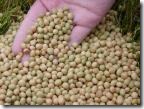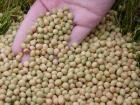 But when the CME Globex session fires up on Sunday evening, corn will find itself sharing the stage with its longtime vaudeville partner as soybeans prepares for its grand entrance.
But when the CME Globex session fires up on Sunday evening, corn will find itself sharing the stage with its longtime vaudeville partner as soybeans prepares for its grand entrance.
The month of July has always belonged to corn. Corn dominates headlines as traders react to every minute change in weather forecasts. This year has been no different, with much-above-average temperatures keeping the market on pins and needles for much of the month and running market volatility up over 40% (considered a high level).
But when the CME Globex session fires up on Sunday evening, corn will find itself sharing the stage with its longtime vaudeville partner as soybeans prepares for its grand entrance. As the crowd screams its approval, the new star of the show breaks into the familiar show tune, "We’re having a heat wave, a tropical heat wave. The temperature’s rising. It isn’t surprising …"
Where the corn crop is made in July, the month of August has always belonged to soybeans. And this year, as the song implies, soybeans take the stage with the roaring oven of an ongoing high pressure ridge parked over the Midwest. However, as we move from act one to act two, theater goers will notice a stark difference in drama.
Corn is the star walking a tightrope without a net. And this year, the tightrope has been set on fire, making a successful passage to the other side — harvest — virtually impossible. Soybeans, on the other hand, have the luxury of working over a safety cushion. In this scenario the safety cushion is the previous marketing year’s global ending stocks turned upcoming marketing year’s beginning stocks. In the case of soybeans, that cushion was projected to be 65.9 million metric tons in the July WASDE report — the largest on record.
Not only is the 65.9 mmt comfortable, even adding in the component of record global demand of 254.2 mmt ending stocks-to-use still comes in at an all-time high of 25.9%. In other words, where corn is a bona fide action/drama star, soybeans could be viewed as comic relief. A look at its market volatility hanging around 20% seems to make the case that besides not having its best acting chops this year, few will take its death howls during August very seriously.
Think of it this way, corn is Denzel Washington. Remember his character’s death in his Oscar winning performance in the Civil War film "Glory?" Soybeans are Keanu Reeves. Enough said.
Before we get ahead of ourselves though, let’s check the program to see what exactly soybeans are supposed to be performing. The setup is this: domestically soybean stocks are still forecast to be relatively tight with the July USDA estimate coming in at 175 mb, putting ending stocks-to-use at 5.4%. Historically, this type of supply-and-demand situation would garner some attention. But in recent years traders seem to have grown numb to domestic ending stocks-to-use being tight, focusing instead on the global situation, correctly, I might add.
As July comes to an end, this year’s soybean crop continues to run comfortably behind the five-year average pace. This coming Monday’s weekly crop progress report will be through July 31 and should show percent blooming at about 90%. Setting pods could be up to about a third of the crop, well behind last year’s blazing pace and just slightly behind average. What this means is that the crop most likely came through the early part of the heat wave unscathed, and if 2010 is any indication, may not have much concern through the first half of August either.
In 2010 the initial yield estimate in May came in at 42.9 bpa and when all was said and done the January "final" estimate pegged yield at 43.5 bpa. This year’s situation is similar with the May yield estimate coming in at 43.4 bpa. If trends hold true to form, soybeans could ultimately see its yield increase to 44 bpa, putting total production over 3.5 bb. If so, and if demand stays near current projections, ending stocks-to-use could climb to 8.6%, the highest since the 18.6% estimated at the end of the 2005-2006 marketing year.
A recent Fundamentally Speaking blog post by DTN Contributing Analyst Joel Karlin discussed the difficulty of reading too much into the soybean crop too early. July indicators are often misleading, with USDA showing a tendency to gradually increase yield estimates from August on. If nothing else, this makes soybeans more consistent then corn (and heaven knows one thing the esteemed thespian Mr. Reeves can claim is consistency), though far less entertaining.
The dog days of August are upon us. The oppressive heat makes everyone irritable, tiring of heavy drama. It’s time for the comic relief soybeans can provide, even if it’s trying to be serious.

Deprecated: strpos(): Passing null to parameter #1 ($haystack) of type string is deprecated in /home/agriviek8Qv/agriviet.net/public_html/wp-includes/comment-template.php on line 2522